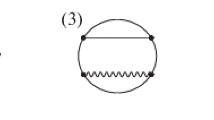Summary
We consider a generalization of the non-Abelian gauge theories, obtained by replacing the Minkowskian space-time by the superspace, and the gauge group by itsZ 2-graded extension. It seems to us that such a theory will contain all the essential features displayed by theN=1,D=10 theories after their dimensional reduction, while being much simpler to formulate. The Grassmann parity of supergauge fields introduced over the generalized graded fibre bundle is supposed to obey some strict rules, namely we propose to add up together the superspace parity and the graded-group parity of the corresponding gauge field components. This amounts to a particular choice of the supergauge, which breaks the conformal symmetry of the theory and generates masses of the Higgs scalar multiplet and of the spinor multiplet. The invariant Lagrangian is computed, which contains the Yukawa coupling, the current-current coupling and the Fermi four-point interaction. The mean mass ratio of Higgs scalarsvs. fermions is obtained. The group representation content of the theory is briefly discussed; it is shown that in this theory there is no place for quark representations if the gauge group isSU 3 orSU 3×U 1; quarks begin to appear only with groups containingSU 4 or bigger.
Riassunto
Si considera una generalizzazione delle teorie di gauge non abeliane ottenute sostituendo lo spazio tempo di Minkowski con il superspazio e il gruppo di gauge con la sua esteusione graduata da Z2. Sembra che una teoria siffatta contenga tutti i requisiti essenziali presentati dalle teorieN=1,D=10 dopo una riduzione dimensionale, pur essendo molto piú semplice da formulare. Si suppone che la parità di Grassmann dei campi di supergauge introdotta sul fascio di fibre generalizzato graduato obbedisca ad alcune regole rigide, cioè si propone di sommare la parità del superspazio e la parità del gruppo graduato delle componenti corrispondenti del campo di gauge. Ciò corrisponde ad una scelta particolare della supergauge che viola la simmetria conforme della teoria e genera le masse del multipletto scalare di Higgs e del multipletto spinoriale. Si calcola il lagrangiano invariante, che contiene l’accoppiamento di Yukawa, l’accoppiamento tra correnti e l’interazione di Fermi a quattro punti. Si ottiene il rapporto medio di massa tra scalari di Higgs e fermioni. Si discute brevemente il contenuto della rappresentazione di gruppo della teoria; si mostra che in questa teoria non c’è posto per rappresentazioni di quark se il gruppo di gauge èSU 3 oSU 3×U 1; i quark cominciano a presentarsi solo con gruppi che contengonoSU 4 o piú grandi.
Similar content being viewed by others
Literatur
D. V. Volkov andV. P. Akulov:Phys. Lett. B,46, 109 (1973).
I. Wess andB. Zumino:Nucl. Phys. B,70, 39 (1974).
R. Arnowitt, P. Nath andB. Zumino:Phys. Lett. B,56, 81 (1975).
K. Gawedzki:Ann. Inst. Henry Poincaré,27, 335 (1977).
P. Nath andR. Arnowitt:Phys. Lett. B,56, 177 (1975).
A. D’Adda, R. D’Auria, P. Fre andT. Regge:Riv. Nuovo Cimento,3, No. 12 (1980).
R. G. Yates:Commun. Math. Phys.,76, 255 (1980).
S. Ferrara andB. Zumino:Nucl. Phys. B,79, 413 (1974).
P. Fayet andJ. Iliopoulos:Phys. Lett. B,51, 461 (1974);P. Fayet:Nuovo Cimento A,31, 626 (1976).
S. Mac Dowell andF. Mansouri:Phys. Rev. Lett. 38, 739 (1977);D. Z. Freedman, P. Van Nieuwenhuizen andS. Ferrara:Phys. Rev. D,15, 3214 (1976).
R. Kerner:J. Math. Phys. (N. Y.),21, 2553 (1980).
D. Domokos andS. Kovesi-Domokos:Phys. Rev. D,16, 3060 (1977).
R. Kerner:Ann. Inst. Henry Poincaré,34, 437 (1981).
J. Iliopoulos andB. Zumino:Nucl. Phys. B,76, 310 (1974).
E. Witten:Nucl. Phys. B,185, 513 (1981);186, 412 (1981).
A. Rogers:J. Math Phys. (N. Y.),22, 939 (1981).
L. Corwin, Y. Ne’eman andS. Sternberg:Rev. Mod. Phys.,647, 573 (1975).
A. Baha Balantekin andI. Bars:J. Math. Phys. (N. Y.),22, 1149 (1981).
R. Kerner: inGroup Theoretical Methods in Physics, edited byC. Sharp andP. Kolman (New York, N. Y., 1977), p. 321.
E. M. da Silva Maia:Lett. Math. Phys.,5, 531 (1981).
J. Rayski:Acta Phys. Pol.,27, 89 (1965).
Y. Thiry:C. R. Acad. Sci. Paris,226, 216 (1948).
E. Cremmer, B. Julia andJ. Scherk:Phys. Lett. B,76, 409 (1978).
J. F. Luciani:Nucl. Phys. B,135, 111 (1978).
W. Thirring: inXI Schladming Conference, edited byP. Urban (Wien and New York, N. Y., 1972).
Author information
Authors and Affiliations
Rights and permissions
About this article
Cite this article
Kerner, R. Supersymmetric kaluza-klein theory. Nuov Cim A 73, 309–326 (1983). https://doi.org/10.1007/BF02734672
Received:
Published:
Issue Date:
DOI: https://doi.org/10.1007/BF02734672



